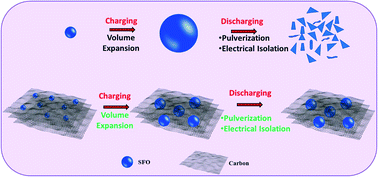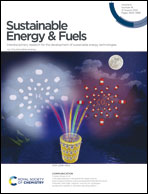Sustainable composite of SnFe2O4 conversion alloying anode for lithium-ion storage†
Abstract
The development of high-performance, low-cost electrodes using sustainable materials for Li-ion batteries is of vital importance in view of their increasing demand for use in electronics and electric vehicles, as we transition from non-renewable energy resources. Challenges associated with commercial graphite anode materials include relatively low capacity, the use of high-temperature synthesis, Li dendrite formation, and limited rate capability. In this study, we present a tin ferrite SnFe2O4 (SFO) conversion alloying material (CAM), and its synergistic composite with a scalable and low-cost waste-derived carbon (WDC), which was prepared by low-temperature pyrolysis of a waste material sustainably. The combination of SFO with the WDC in the composite boosts the conductivity, diffusion kinetics, stability, and reversibility, and accommodates volume expansion upon cycling. The first charge capacity obtained for WDC, SFO, and SFO–WDC is 595, 1269, and 1331 mA h g−1, respectively at 100 mA g−1 in a Li-ion half-cell. In a full cell fabricated with LFP, a stable capacity of 80 mA h g−1 at 100 mA g−1 could be obtained, and the corresponding energy density for the SFO–WDCIILFP full cell is 300 W h kg−1. Kinetic studies revealed that capacitance-controlled charge storage is dominant so the capacity was higher in the composite. This composite system addresses both the low capacity issue of the carbon anode and stability issues of CAMs while being compatible for use with current Li-ion battery technology.



 Please wait while we load your content...
Please wait while we load your content...